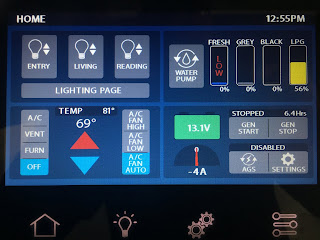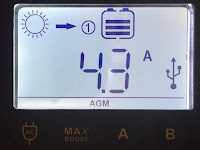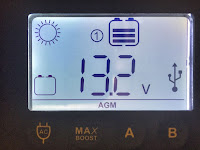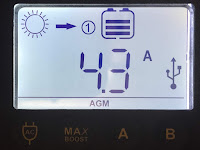New RV owners often ask if they can leave the inverter, the fan, or some other appliance on. We all want to understand how long the power in our batteries will last. Newer Pleasure-Way vans include a tool, the Spyder Control Panel, that helps answer this question. If you don’t have lithium batteries and a Spyder Control, check out our post on how to install a Smart Gauge.
The Short Answer
On the Spyder Control Panel home screen, a “Loss/Gain Amperage Meter” shows the current in “Net amps.” It is the “-4A” shown in the picture. Net amps means the amount of current going into the batteries less the amount being pulled out of the batteries. The secret to learning how much current an appliance uses, is eliminating any current going into the batteries. Eliminating any incoming current leaves how much current is being used by appliances showing on the meter. Here are the steps:
1) Turn off any charge sources
2) Turn on only the appliances you are interested in understanding
3) Read the number of amps (A) from the meter (it will be a negative number)
4) Multiply this number times the number of hours you will use the appliance to get the number of amp hours (Ah) that the appliance(s) will draw.
5) Subtract this from your usable battery capacity (160 Ah in the 200 Ah batteries) and you will know how long the appliances can be run without recharging your batteries.
Example: Refrigerator on DC shows -16A. If we run it 10 hours overnight, it will exhaust the the entire 160 Ah usable capacity of the house batteries. That’s why we run the fridge on propane whenever we aren’t driving! Here are the calculations.
6) Now go ahead and turn your usual charge sources back on so you don’t run out of power.
The Longer Answer
Insure there is no power going into the batteries. Pleasure-Way gives us lots of power sources, so here are all the sources of charging you need to make sure you aren’t using before you can measure appliance power usage.
1) Disconnect shore power
2) Turn off the van engine
3) Turn off the generator
4) Turn off solar panels (use the red key) or wait until after sunset
With these off, you can turn appliances on and look at the reading on the Loss/Gain Amperage Meter to see what each appliance, or combination of appliances, pull from your batteries. Here are some of the readings we found in our 2018 Lexor TS.
Amps Appliance
-1 Inverter with no load
-1 Propane Switch (in the on position)
-1 Two phones charging via USB
-1 Valence lights
-3 All interior lights
-2 TV with antenna amplifier
-1 Vent Fan at 20%
-3 Vent Fan at 100%
-5 Furnace fan
-16 Refrigerator on DC
-142 Microwave through inverter
Note that these are rounded to the nearest amp because the meter doesn’t read less than 1 amp.
Amps is current used at a single point in time. If we want to know how much is being used over a longer period of time, we calculate Amps (A) x Hours (h) to get Amp Hours (Ah).
For example, using the 2 amp TV for 4 hours would consume 8 amp hours from our battery ( 2A x 4h = 8 Ah).
If we run the fantastic fan at 20% and have the propane switch on for eight hours, we’ll consume 16 amp hours from our house battery bank ((1A+1A) x 8h = 2A x 8h = 16Ah) .
Boondocking example
Say we want to stay in a park that doesn’t allow generator usage or have any plug-in power for three days. Here’s how to estimate if there will be enough power. First we estimate how long we will use an appliance each day and calculate how many amp-hours that consumes.
Hrs Amps Amp-hrs Appliance
24 x 1 = 24 Propane Switch
8 x 1 = 8 Inverter
2 x 3 = 6 Fan at 100%
8 x 1 = 8 Fan at 20%
6 x 1 = 6 Lights
52 Total
Multiplying hours by amps, then adding up the amp-hours, we get 52 amp hours each day. With no other usage, we would have 3 days worth of power with some to spare 52 x 3 = 156. Subtract that from our 200 amp-hour lithium battery capacity and we have 44 amp hours or a little over twenty percent remaining after three days. Read on to see why that is really closer to zero percent.
Battery Capacity
Although the Lithium batteries in the van have a capacity of 200 amp hours, that isn’t the same as usable capacity. Just like cell phones or computer batteries, in order to preserve their life, we shouldn’t use more than 80% of the total capacity before recharging. Taking 200 Ah x 80% gives us a usable capacity of 160 Ah. While it is disappointing that we can’t use the total capacity, lithium batteries are considerably better than older wet cell or AGM batteries where only 50% of the capacity is usable. We had a 110 Ah AGM battery in our previous RV that only had 55 Ah of usable capacity. The lithiums in our new Lexor give us almost 3x the usable capacity.
More Input
But wait, don’t we have power coming in through the solar panels that can extend our boondocking time? Yes, if you have solar panels, there is power coming in to offset the appliance consumption. So how much power? Pleasure-Way offers from one to three panels, each rated at 95 watts. Watts doesn’t help us much because all our meter shows is amps. To convert watts to amps, we divide by the voltage. Since our vans run on 12 volt power, divide 95 by 12 to get 7.9 amps. Unfortunately, solar panels aren’t 100% efficient, so we need to further reduce this by 35% to get 5.1 amps. Round this to 5 amps and multiply times the number of panels on your van to get the total number of solar amps available. We have three panels so we have (3 x 5 = 15 amps) of solar.
How Much Sun?
If we have 12 hours of daylight, do we get 12 hours x 15 Amps = 180 Ah of charge every day? Unfortunately the answer is no. Solar panels only provide their full output when the sun is close to overhead so they are hit by direct sunlight. A good rule of thumb is to use six hours per day. This gives us 6 hours x 15 amps = 90 Ah added to the batteries every day.
Going back to our boondocking example, if we use 52 Ah each day, but are charging 90 Ah from our solar cells, we won’t ever run out of power (90-52 = +38 Ah per day). Note that there are all kinds of things that can reduce solar panel efficiency; heat, shade, clouds, dirty panels etc… so it is good to build a safety margin like the 38 Ah above into your calculations.
How do you know how much solar charge your batteries are getting right now? The Go Power charge controller has a panel that will display that info.
Here the solar panels are adding 4.3 amps to the batteries. If you don’t see this screen, push the “B” button repeatedly to cycle through
Voltage,
Battery Charge %,
(this isn’t really an accurate % of charge indicator because it is designed for AGM, not lithium batteries. A shunt based meter would be needed if you really want to monitor power in and out of your battery bank.)
to Amps.
In this case, it was late afternoon and shady, so we weren’t seeing the 15 amp maximum our combination of three panels can produce.
If the camping area allows it, you can always start the generator and recharge your batteries, but we prefer the quiet of solar and only use the generator if we really need air conditioning. Note that the air conditioner isn’t even wired to the inverter since it would overpower the inverter. Even if the inverter was higher power, the air conditioner would drain the 200 Ah batteries in less than an hour.
The bottom line for us is, with three 95 watt solar panels and the refrigerator running on propane, we run out of water, or fill our holding tanks, long before we run out of electricity.
An electrical engineer could calculate more accurate numbers with an understanding of how capacity is depleted or gained at differing rates of charge, but the above guidelines have been close enough for our purposes.
Some good battery and charging information is available on-line. One of the best sources is the DIY Instructions area on the AM Solar website –> Click here for link
My reference for all things electrical is the Boatowner’s Mechanical and Electrical Manual by Nigel Calder. The most current issue, as of March 2019 is the Fourth Edition (2015). There might be an equivalent book that is specific to RV systems, but this is the most understandable, thorough, and best illustrated book I’ve found. Please leave a comment, if you have a favorite electrical systems book to recommend.
|
12 Volt LiFePo4 |
|
|
No Load Voltage |
Capacity Remaining |
|
14.340 |
100% |
|
13.300 |
90% |
|
13.270 |
80% |
|
13.160 |
70% |
|
13.130 |
60% |
|
13.116 |
50% |
|
13.104 |
40% |
|
12.996 |
30% |
|
12.866 |
20% |
|
12.730 |
10% |
|
9.200 |
0% |
|
Do not allow resting voltage to fall below 12.86 Volts |
|
If you really want to know your battery state of charge, consider installing a Victron battery monitor. It uses a shunt to measure amps in and out of your batteries. The current model that several Pleasure-Way owners have installed is the BMV-712 Smart Monitor.





Leave a Reply